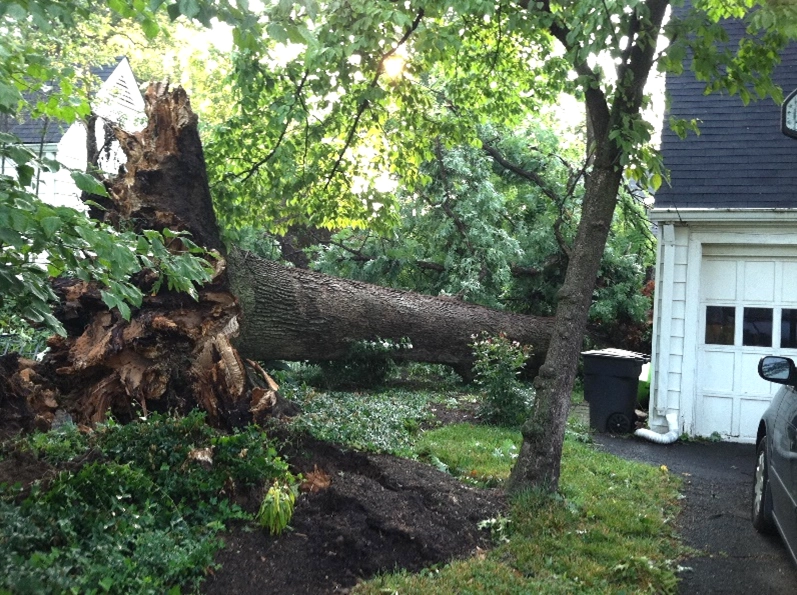
Trees are beautiful. They cool our Earth, buffer noise, and drink up stormwater. They offer habitat to birds, and so much more.
Trees can make beautiful, natural borders between properties. But, from time to time, they do play a role in tensions between deed holders.
Today we explore a few common conflicts related to trees near property lines. How can resolutions play out in various scenarios?
A Tree Falls Over My Property Line. Who Must Pick Up the Pieces?

You might be surprised. The task generally “falls on” the deed holder for the land where the branch fell — even though it’s not their tree.
But of course, there’s more. And it involves whether the deed holder who owns the tree should have prevented the accident. That means the accident wasn’t a random occurrence. If the neighbor neglected the tree, leading to hazardous conditions, the negligent neighbor needs to cover the costs of cleanup.
What if the tree is somewhere on the spectrum from healthy to hazardous?
A common scenario involves mature trees that begin to drop limbs in storms. The people next door complain. But the issue is ignored. So the concerned neighbors call out an arborist to check the tree. It’s diseased, and they notify the owner of the land with the tree, requesting preventative work.
If the neighbors wind up in litigation, the tree expert can help the court determine liability based on negligence.
Why Should My Neighbor Care What My Tree Does?
Your neighbor might have a justifiable complaint for a private nuisance if your tree interferes with their enjoyment of their own property. Or they could claim you’re being negligent if you’re not behaving with reasonable care.
Court cases are expensive to undergo, and they can leave lasting bad feelings. The best resolution for tree-related disputes? Talk it out, come to an agreement, and stick to it. But if that’s simply impossible, the parties may have a court hear both sides and determine the actions to be taken.
Did the neighbors behave unreasonably? Did they cut down or chemically damage a tree on your property? You have a right to recover your losses. For example, you might need a survey to demonstrate it’s your tree. You might have to hire experts to inspect the tree and your landscaping. And you want your tree replaced.
While you’ll never get the same tree back, at least the law can help financially.
What About Overhanging Branches, Wandering Roots, or Intruding Bamboo?
A dead bough is hanging over your property. You know it’s likely to give out in the next windy storm. Jared, your neighbor, hasn’t responded to your note asking for professional attention to the tree. Fearing potential damage to your home, you have the work done. It’s legally on your neighbor to reimburse you, because Jared knew (or reasonably should have known) of the hazard.
But exercise care. You may not have tree work done that damages Jared’s tree.
OK, what if your tree is growing over Jared’s property? You may have tree work done on it. You are responsible to cover any damage that this might cause to Jared’s property.
Tree roots or bamboo moving into a neighbor’s property may be deemed a nuisance or a trespass under your state’s law. If so, the impacted party may have tree work done and go after other legal remedies.
In Pennsylvania, for example, a deed holder can ask a court to direct the neighbor to remove bamboo or problematic root systems and be reimbursed.
By the same token, some state courts have classified tree limbs as a trespass. The offended neighbor may cut branches up to the property borderline. State law might also allow for reimbursement for any professional tree work.
What’s Up With Trees, Sidewalks, and Utility Lines?
The local government handles maintenance of trees in the public right of way — even though the same trees are owned by the landowners along the sidewalk.
But…
Property owners at the corners must not let trees and shrubs block the view of turning drivers.
And…
Landowners have the legal obligation to fix their sidewalks — even if they have to fix breakage from a trunk of a tree that the town maintains.
But…
The town does have to step up and take legal responsibility for injuries caused by trees falling in the public walkway on account of poor maintenance. (Sometimes, a local ordinance might expressly assign that duty to the landowners along the walkway. But if the landowners do not step up, the town must.)
You’ll find that courts have said municipalities aren’t responsible for the (often cringeworthy) tree work that’s ordered by the electric company. We all need electricity and we all have to defer to the electric company’s methods.
Where Are the Laws That Apply to Me?
The laws of trees and deed holders flow from:
- Decisions issued by the courts.
- Statutes drafted by state lawmakers.
- Local ordinances enacted by towns and cities.
Local ordinances set forth the deed holder’s duties regarding tree placement and maintenance expectations where the public interest is involved. There might be language in your municipal ordinances that direct the taking down of nuisance or hazard trees in the public right of way, for example. A deed holder who ignores the ordinance could be hit with a court-issued order to take action, or fines, or both.
But disagreements between neighbor and neighbor aren’t the local government’s problem. They are a private matter, to be sorted out by the deed holders themselves.
“See You in Court!”
The disagreeing parties can call lawyers to represent them if necessary. A wise lawyer would usually nudge a deed holder — even one who has a strong claim — to be open to the other side’s perspective, and try to reach an agreement that both can tolerate. If that just won’t work, a lawyer can send a demand letter, explaining why you are likely to win in court.
Granted, some situations might need the help of a court to clarify the parties’ rights. Say, for example, the property line passes through a hazard tree, so it’s growing from both sides. Whose job is it to handle the hazard? A lawyer might make the case that it’s your neighbor’s job by showing that your property holds a smaller proportion of the tree.
Always check your own state and local laws and regulations. State law can vary, even on an issue as old and sturdy as an oak. And remember: This website is not intended as legal advice. The articles on Deeds.com are offered as basic information only. They do not substitute for a consultation with a lawyer in your state.
Supporting References
Gilbert P. High, Jr. in the WeConservePA Library (Pennsylvania Department of Conservation and Natural Resources, Bureau of Recreation and Conservation): Tree Law in Pennsylvania (2022). See also: WeConservePA Library Tree Ordinance.
Deeds.com:Trees, Smoking, and Other Neighbor Troubles – What’s a Homeowner to Do? (Aug. 25, 2023).
And as linked.
More on topics: Property surveys, New property lines
Photo credits: Defense Visual Information Distribution Service, in the Public Domain via Picryl; and Albert Herring on Flickr via Wikimedia Commons CC-BY-SA 2.0.
